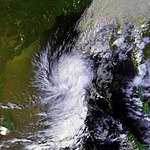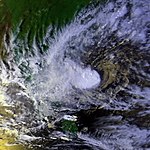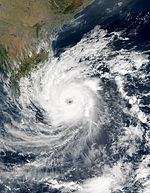2000 North Indian Ocean cyclone season
| 2000 North Indian Ocean cyclone season | |
|---|---|

Season summary map
|
|
| Seasonal boundaries | |
| First system formed | March 27, 2000 |
| Last system dissipated | December 28, 2000 |
| Strongest storm | |
| Name | BOB 05 |
| • Maximum winds | 190 km/h (115 mph) (3-minute sustained) |
| • Lowest pressure | 958 hPa (mbar) |
| Seasonal statistics | |
| Deep depressions | 6 |
| Cyclonic storms | 5 |
| Very severe cyclonic storms | 2 |
| Super cyclonic storms | 0 |
| Total fatalities | 238 |
| Total damage | $185 million (2000 USD) |
| Related articles | |
| Cyclonic storm (IMD) | |
| Tropical storm (SSHWS) | |
| Duration | March 27 – March 30 |
|---|---|
| Peak intensity | 85 km/h (50 mph) (3-min) 998 hPa (mbar) |
| Depression (IMD) | |
| Duration | August 23 – August 24 |
|---|---|
| Peak intensity | 45 km/h (30 mph) (3-min) 994 hPa (mbar) |
| Cyclonic storm (IMD) | |
| Tropical storm (SSHWS) | |
| Duration | October 15 – October 19 |
|---|---|
| Peak intensity | 65 km/h (40 mph) (3-min) 996 hPa (mbar) |
| Cyclonic storm (IMD) | |
| Tropical storm (SSHWS) | |
| Duration | October 25 – October 29 |
|---|---|
| Peak intensity | 65 km/h (40 mph) (3-min) 998 hPa (mbar) |
| Extremely severe cyclonic storm (IMD) | |
| Category 1 tropical cyclone (SSHWS) | |
| Duration | November 26 – November 30 |
|---|---|
| Peak intensity | 190 km/h (115 mph) (3-min) 958 hPa (mbar) |
| Extremely severe cyclonic storm (IMD) | |
| Category 1 tropical cyclone (SSHWS) | |
| Duration | December 23 – December 28 |
|---|---|
| Peak intensity | 165 km/h (105 mph) (3-min) 970 hPa (mbar) |
The 2000 North Indian Ocean cyclone season was fairly quiet compared to its predecessor, with all of the activity originating in the Bay of Bengal. The basin comprises the Indian Ocean north of the equator, with warnings issued by the India Meteorological Department (IMD) in New Delhi. There were six depressions throughout the year, of which five intensified into cyclonic storms – tropical cyclones with winds of 65 mph (40 km/h) sustained over 3 minutes. Two of the storms strengthened into a very severe cyclonic storm, which has winds of at least 120 km/h (75 mph), equivalent to a minimal hurricane. The Joint Typhoon Warning Center (JTWC) also tracked storms in the basin on an unofficial basis, estimating winds sustained over 1 minute.
The first storm of the season originated toward the end of March in the Bay of Bengal, one of only five March storms at the time in that body of water. Strong wind shear, which plagued several storms during the season, caused the storm to rapidly dissipate over open waters. In August, a weak depression struck the Indian state of Andhra Pradesh, producing additional flooding after a deluge affected the area in July. There were 131 deaths in Andhra Pradesh, mostly by drownings or collapsed walls, while damage was estimated at ₹7.76 billion rupees ($170 million USD). There were two short-lived storms in October – one dissipated offshore India in the middle of the month, and the other struck Bangladesh toward the end of the month. The latter storm destroyed many homes and boats, killing 77 in Bangladesh including 52 fishermen, and damage in the Indian state of Meghalaya was estimated at ₹600 million rupees ($13 million USD). The strongest storm of the season struck Tamil Nadu in November, causing damages of ₹700 million rupees ($15 million USD) and 12 deaths. The final storm of the season hit eastern Sri Lanka, leaving 500,000 homeless and killing nine.
...
Wikipedia










